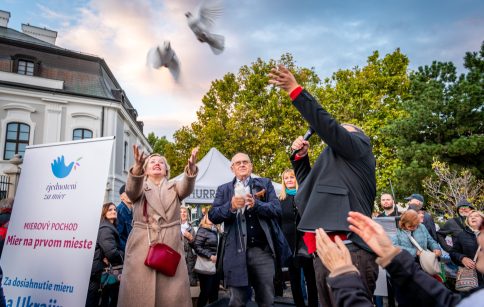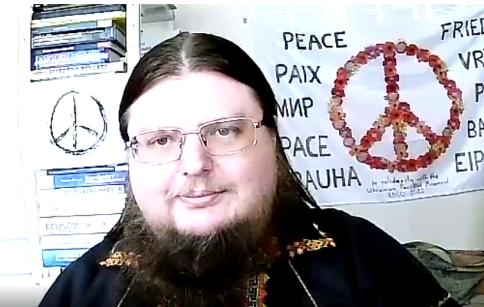IVETA KOMPISOVA, 29.05.2021
Every year on 29 May, the international community commemorates United Nations (UN) peacekeeping missions. The UN General Assembly (UN General Assembly) declared this day by approving a resolution of 11 December 2002, and although only mentioned since 2003, soldiers, police officers and civilian experts have been helping to keep the world peace for 73 years under the auspices of the United Nations. This day pays tribute to all the men and women who have served and are serving in peacekeeping operations, and their high level of professionalism, dedication and courage is appreciated.
The first UN peacekeeping mission has been established May 29, 1948, when the United Nations Security Council (UNSC) authorized the deployment of a small number of UN military observers in the Middle East to form the United Nations Truce Supervision Organization (UNTSO) with a mission to monitor the Ceasefire Agreement between Israel and its Arab neighbors. This ceasefire marked the end of hostilities between Israel and the League of Arab States (fighting began after the end of the British Mandate of Palestine on May 14, 1948).
Originally, the UN peacekeeping force served primarily to separate the opposing parties, only sometimes to ensure that the fighting stopped. According to the then UN Secretary-General (UNSG) Daga Hammarskjöld, the peacekeeping force was to have four restrictions: 1. were construed as interim measures taken without prejudice to the views of one of the opposing parties; 2. peacekeeping operations could only be conducted with the consent of all parties to the conflict; 3. peacekeeping forces could only use weapons in self-defense; 4. USSR and US soldiers should not be called in peacekeeping forces. However, the development of UN peacekeeping activities proceeded differently.
Gradually, the following types of objectives and concepts of the armed forces began to be functionally distinguished:
- Peace-keeping and peacekeeping force . It is a matter of deploying UN troops and missions directly to the site of the conflict, and the fulfillment of this task presupposes the consent of all parties to the conflict to the UN intervention. In the context of UN peacekeeping operations, non-combat operations of deployed forces are expected in particular – the force can only be used for self-defense, for defending its mandate, for civilians and in situations where the state is unable to provide security and maintain public order. The task of peacekeeping is to expand opportunities for conflict prevention as well as peace-building. The main institutions and peacekeeping objectives are considered to be:
- Observation missions . These are usually unarmed monitoring of ceasefire compliance, established demarcation lines, confirmation of the departure of armed forces from the conflict area, respect for human rights, election preparation and surveillance, etc.
- Mediation forces . The purpose of such missions is to isolate enemy forces after a temporary ceasefire or the conclusion of a ceasefire agreement. The tasks of the missions include the establishment of observatories, monitoring of ceasefires, surveillance of major roads and terrain that could be used by the parties to the conflict to gain additional benefits, demarcation line inspections, opening of corridors for humanitarian aid, escorting convoys with humanitarian aid, building buffer zones and demilitarization control, etc.
- Missions to ensure the transition from armed conflict to a peaceful solution . After completing military tasks in connection with the ceasefire in the work of these missions, civilian tasks prevail – co-creating the conditions for a return to peaceful life. The objectives of such operations include surveillance of the departure, relocation, demobilization and disarmament of military and paramilitary groups, ceasefire surveillance, confiscation of weapons, ammunition and supplies, mapping and clearing of minefields, civilian assistance, construction or repair of infrastructure, assistance in refugee return, etc.
- Arms control . It is a whole range of activities from inspections through verification of compliance with agreements to the deployment of troops, forced demobilization, removal and destruction of weapons, etc.
- Peace -enforcement . It is a military coercive intervention carried out after the failure of peacekeeping efforts. Peace enforcement is the deployment of armed forces without the consent of the parties to the conflict or the state in which they operate, with the aim of a direct or indirect clash with the armed forces or other units of the parties to the conflict. Only the UN Security Council can decide on its implementation. The goal of the operation is not a military victory, but forcing the enemy to comply with the requirements of an approved UN resolution, mandate or sanctions.
- Peace -making and peacemaking force. It is an activity aimed at reaching an agreement between the enemy parties, in particular by peaceful means, as set out in Chapter VI of the UN Charter.
One of the most significant contributions to defining the UN’s role in resolving conflicts in the world was the initiative of the then UN General Assembly, Butrus Butrus-Gali (in office in 1992-1996), entitled An agenda for peace. Preventive diplomacy, peace enforcement and peacekeeping ( https://www.un.org/ruleoflaw/files/A_47_277.pdf ) of 1992. In a broader context, the Agenda for Peace was to be a milestone in the transition from the Cold War (in which United Nations activity was limited by rival superpowers) to an era in which the world organization was to return to fulfilling its mission. This goal has remained unfulfilled, but still relevant. The initiative has defined the different types of activities and their roles, and the UN peace agenda should, according to this concept, include:
- Establish an early warning system for assessing potential peace threats.
- Deployment of forces in areas where there is an acute threat of armed conflict. When the conflict exceeds the capabilities of these forces, deploy forces to enforce peace.
- The role of regional organizations should be strengthened.
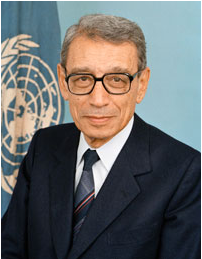
Butrus Butrus-Gálí. Source: https://www.un.org/sg/en/content/boutros-boutros-ghali
The term peace -building , which is a task with a military as well as an economic, social and cultural dimension, also appeared in the mentioned material. Post-conflict peace-building can take the form of concrete cooperation projects that bring together two or more countries in a mutually beneficial commitment that can not only contribute to economic and social development but also increase confidence, which is essential for peace. Peacebuilding is a step towards reducing the risk of a country slipping or returning to conflict by strengthening national capacities in conflict management and laying the foundations for sustainable peace and development. Thus, peacekeeping operations were to provide an ever-widening range of tasks, such as maintaining a secure environment, disarming fighters and reintegrating them into civilian life, supervising elections, providing support to returning refugees, economic recovery assistance, police and military training and monitoring, judicial reform and Come. Another feature was the deployment of peacekeepers in areas of active conflict in order to deliver humanitarian assistance to the local civilian population and also to contribute to their protection through the deterrent that the presence of troops was supposed to bring.
Subsequently, a UN emergency preparedness system was developed based on the commitment of Member States to contribute to joint military operations at an agreed time, based on their capabilities. During its implementation, a project of The International High-Readiness Brigade (SHIRBIG) was created on the basis of a Danish proposal from 1995. It was an international military unit serving the needs of the UN Security Council, which provided approximately 5,000 troops ready for deployment in 15 to 30 days for half a year. He has been active since 1. 1. 2000 to 30. 6. 2009.
Building lasting peace in war-torn societies is one of the challenges for global peace and security that is perhaps the most respectful. In 2005, the United Nations established the Peacebuilding Commission to better anticipate and respond to peace-building challenges, which, as an intergovernmental body, have an advisory role. The Commission is to bring together all relevant players in pooling resources, proposing strategies for peace-building and post-conflict reconstruction, including reconstruction and institution-building efforts needed to recover from conflicts and support the development of integrated strategies to lay the foundations for sustainable development. At the same time, it provides recommendations and information to improve coordination between all relevant actors within and outside the UN, develops best practices, assists in providing predictable funding for early recovery activities and ensures that the international community pays attention to post-conflict reconstruction. The Commission has 31 members: seven elected UN General Assembly, seven elected UN Security Council and seven elected by the UN Economic and Social Council (ECOSOC). TOP5 donors to UN missions and TOP5 contributors to UN budgets are also members.
At its meeting in 2019, the UN General Assembly elected Slovakia and Peru as two new members of the Peacebuilding Commission for the period 2020-21. The Slovak Republic has been since 1. January 2020, one of the 31 members of the Commission, whose main objective is to support peace activities in conflict – affected countries and is a key supporting body in the wider peacekeeping agenda. Slovakia thus underlined the active commitment to peacebuilding and other issues closely linked to it: peace operations, conflict prevention and mediation, security sector reform (SSR), sustainable development / Agenda 2030, the rule of law, human rights, and. i.
Since 1994, the UN has been cooperating with regional organizations in its peacekeeping operations through consultations, diplomatic support, operational support, joint deployment and joint operations (eg in Haiti, the Organization of American States has participated in UN actions).
Since the first mission in 1948, more than 1 million women and men have served in 72 UN peacekeeping operations, directly affecting the lives of millions and saving countless lives. Today, the UN peacekeeping force is deploying more than 89,000 military, police and civilian personnel in 12 operations.
Today’s multidimensional peacekeeping operations aid the political process, protect civilians, disarm, demobilize and reintegrate former fighting forces, support elections, protect and promote human rights, and help restore the rule of law. The blue helmets also ensure that refugees and detainees can return to their homes. It is not mandatory for all states to participate in missions. However, no state can be ruled out unless it is directly involved in a dispute or problem that the UN is currently addressing if it is interested in participating in such measures.
1988: NOBEL PEACE PRIZE
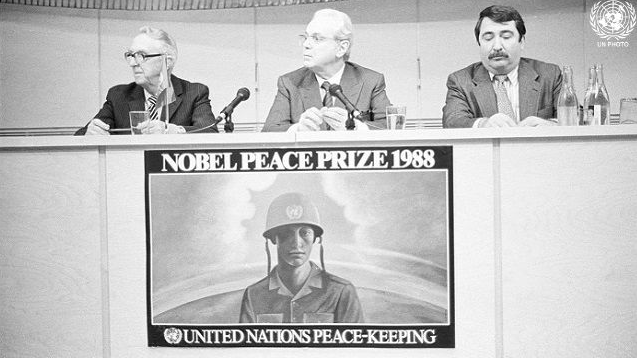
Source: https://www.unmultimedia.org/avlibrary/asset/C892/C892/ . On this page you can listen to the entire performance of the Nobel Peace Prize.
In 1988 , the UN peacekeeping forces of the UN were awarded the Nobel Peace Prize “For the prevention of armed clashes and the creation of conditions for negotiations.” The peacekeeping force has made a significant contribution to the realization of one of the fundamental principles of the United Nations. The world organization has thus begun to play a more central role in world affairs with growing confidence. “Speaking at the then UN General Assembly Javier Pérez de Cuéllar Guerra, he said: This is, in fact, the exact opposite of the military measures against aggression set out in Chapter VII of the UN Charter. The peacekeeping technique, which has already proved its worth in fifteen operations around the world, can help us cross the border from a world of international conflict and violence to a world in which respect for international law and authority overcomes war conflicts and ensures justice. Peace operations symbolize the will of the world community for peace and represent an impartial and practical expression of this will. The award of the Nobel Peace Prize to these operations sheds light on and reinforces the promise of this extraordinary concept. “
REFORM OF THE SYSTEM OF PEACEFUL OPERATIONS
On the other hand, it must be said that practice shows that at least the same problems that often accompany the approval of operations, their provision and execution also exist with the departure of these forces. At the same time, the tragic events that have taken place, especially in Somalia, Rwanda and the former Yugoslavia, have highlighted the limits of the general policy and doctrine of peace operations set out in the Peace Agenda and have failed to address the responsibility of peacekeeping missions. Peacekeeping operations, due to their limited military objectives and their unsuitability for administrative and police service, often failed to ensure that riots and new fighting did not break out after their departure. In the context of some of the controversial results of the peacekeeping missions, the possibility of reforming the UN peacekeeping system has therefore begun. Although the Agenda for Peace has never been fully implemented, its basic structure and conceptual framework in relation to the reform of peacekeeping missions have remained valid. The road to reform began in 1997, when the then UN GT Kofi Annan issued a report on reform efforts – Renewing the United Nations: A Program for Reform . One of the key documents that played an important role in initiating the reform within the UN is the so-called Brahimi Report issued in 2000 by the UN Panel on Peacekeeping Operations. The report assesses the current situation, examines the possibility of making peacekeeping operations more effective and proposes concrete procedures to strengthen the capabilities of peacekeeping operations under a UN mandate. The UN Security Council subsequently adopted a resolution addressing the implementation of the proposed steps. In 2008, a publication was published on the principles and principles of UN peacekeeping missions, also known as the so-called Capston’s doctrine . It is a document that summarizes and sets out the overall doctrinal framework for UN peacekeeping operations, to which all other internal guidelines, principles, operational standards, manuals and training materials are to be subject. It was the first time that the doctrine of peacekeeping missions was adopted in such a comprehensive form. Another initiative in the internal effort to reform UN peacekeeping operations is the 2009 New Horizon for UN Peacekeeping Operations . It reviews the operation of UN peacekeeping operations in the context of support for four priority areas – political development, capability development, field support, planning and surveillance. The document itself alleges that it builds on the Brahimi report and aims to set out the immediate, medium- and long-term goals that the UN is seeking to achieve in peacekeeping operations. It is a contribution to the debate on the future development of UN peacekeeping operations and the principles to be followed and the current challenges.
At present, there is a continuing need to actively support the process of reviewing UN peacekeeping and peacekeeping activities to date and reviewing their mechanisms, as well as to promote the protection of civilians and the security of UN and other international personnel as an integral part of peacekeeping missions.
UN PEACE MISSIONS AND SLOVAKIA
The Slovak Republic is a participant in resolving and preventing conflicts in the world through members of the Slovak Armed Forces, police force, experts and diplomats, but also in the form of Slovak humanitarian aid and development cooperation projects in countries affected by military conflicts. Since its inception in 1993, the Slovak Republic has been sending troops to promote peace under the auspices of various international organizations. For the first time, Slovak troops joined the UN peacekeeping mission in 1993-1996 in the former Yugoslavia as part of the UNPROFOR mission. Members of the Seredi Engineer Battalion provided support to international troops in Croatia and Bosnia and Herzegovina in the areas of demining, road repairs, bridge construction and renovation. At the same time, they helped the local population to rebuild the destroyed infrastructure. During this period, they built 37 bridges, modified 631 kilometers of roads, destroyed more than 30 tons of ammunition of various kinds and inspected 363 km of roads and an area of almost two million square meters. Currently, Slovak troops are working in two UN missions, namely the UNFICYP mission in Cyprus and the UNTSO observation mission in Israel and Syria.
Slovakia declares its support for the strengthening and streamlining of UN peacekeeping operations as part of the ongoing reform of the UN peace and security pillar, as evidenced by its accession to the Declaration of Collective Commitments to make UN peacekeeping operations more effective in September 2018.
Honoring the memory of the soldiers who lost their lives
At the same time, today we commemorate those who underwent the highest sacrifice during their service in UN peacekeeping missions and laid down their lives in them. More than 4,000 UN peacekeepers have been killed in peace service over the past 73 years, including 130 last year.
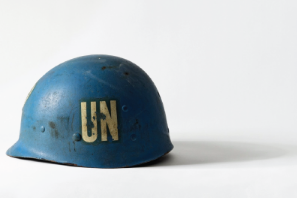
Source: MFA SR
According to the Ministry of Defense, more than 15,500 Slovak soldiers have taken turns in international crisis management missions and operations since the establishment of the independent Slovak Republic. 51 professional soldiers lost their lives while performing tasks during peacekeeping missions. At present, 463 members of the Armed Forces of the Slovak Republic work in international crisis management missions and operations.
DAM HAMMARSKJÖLD’S MEDAL AND GENDER LAWYER AWARD
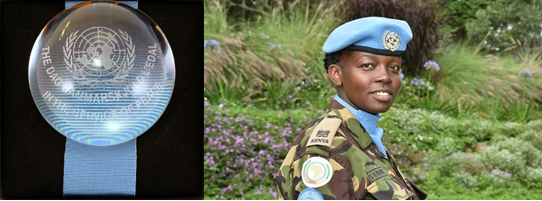
Daga Hammaskjöld medal and awarded major Steplyne Nyaboga from Kenya. Source: UN News
On this occasion at the UN headquarters in New York, the UN Secretary-General laid down 27. May a wreath in honor of all peacekeepers who have lost their lives in the UN-flagged service over the past seven decades. There was also a virtual ceremony at which the UN GT posthumously presented the Daga Hammarskjöld medal to 129 peacekeepers who lost their lives in 2020 and January 2021. At the virtual ceremony, A. Guterres also presented the Military Gender Advocate of the Year award. This year, it was acquired by Major Steplyne Nyaboga from Kenya, who recently ended her deployment in the UN-AU mission in Darfur (UNAMID). During her mission, she introduced new perspectives and raised awareness of key issues affecting women and children, while helping to strengthen cooperation with local communities. Since 2016, this award recognizes military peacekeepers who promote the principles of UNSCR No. 1325 on women, peace and security in UN peacekeeping operations, which will be discussed below.
2021: PROMOTING YOUTH, PEACE AND SECURITY
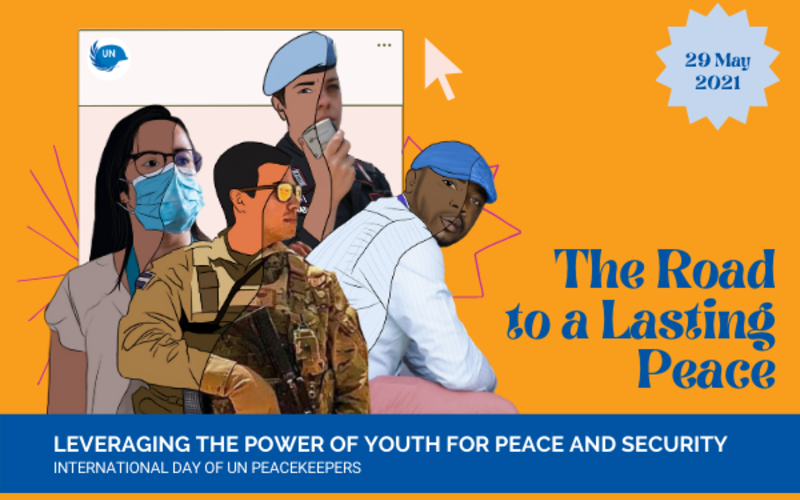
Source: https://peacekeeping.un.org/en
This year , the challenges and threats facing peacekeepers are even greater than ever because, like people around the world, they have to cope with the COVID-19 pandemic, but also with the continuing need to support and protect people in countries in which they are located. The theme of this year’s International Day is The Road to a Lasting Peace: Leveraging the Power of Youth for Peace and Security .
Today, there are tens of thousands of young peacekeepers (aged 18 to 29) around the world, who play a key role in helping missions carry out their mandated activities, including the protection of civilians. And UN peacekeeping operations – in line with UNSC resolutions (2250, 2419 and 2535) – are stepping up cooperation with youth and youth groups to help build sustainable peace and implement their mandates in practice.
It is assumed that conflict prevention and resolution are more sustainable, taking into account the perspectives of young people. The involvement of young people and youth leaders in peace efforts, decision-making and institutional reform processes provides an opportunity to constructively influence areas that directly affect their lives. In 2015, the UN Security Council adopted Resolution 2250 on Youth, Peace and Security, which recognizes, for the first time, “the important role that youth can play in conflict prevention and resolution and as a key aspect of sustainability; , the integration and success of peacekeeping and peace-building efforts. “

Source: https://peacekeeping.un.org/en/promoting-youth-peace-and-security
Also in 2020, the UN Security Council recognized for the first time in Resolution 2553 the link between security sector reform and youth peace and security, recognizing that young people should be involved in peace-building efforts to reform countries’ security sectors.
WOMEN, PEACE AND SECURITY
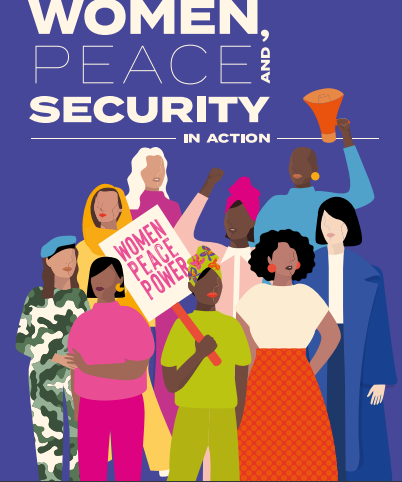
Source: https://www.unwomen.org/en/what-we-do/peace-and-security
Although women continue to be a minority within the warring parties and actors in the war, they are increasingly suffering from it. One of our goals is to promote the active involvement of women in political life . For us as a peace-promoting association, it is important to remember in particular the role of women in building peace and a peaceful future . In the past, peace and security were considered a predominantly male affair. The reason for this was simple; the men were the ones responsible for the war, and therefore they were also considered those who were to bring peace. The reasons were also given that women are too ignorant, emotional and weak to cope with the reality of an often ugly and brutal world. We had to be protected from all threats and take care of the children and the household. Today, however, we know that this thinking was not entirely correct – women are strong advocates of peace and are taking bold steps to stop the war. Women have the necessary versatility and talent to make high-quality contributions to peaceful and foreign policy solutions, even at the highest levels.
There is no doubt that women play an important role in peace processes – for centuries women around the world have played a key role throughout the conflict, as recognized by the UN Security Council in 2000. resolution no. 1325 on women, peace and security – one of the most important documents in the field of peace enforcement and international security policy. The resolution, a historic milestone in the area, was adopted unanimously on 31 October 2000 as the first UNSC resolution specifically addressing the impact of war conflicts on women and seeking to strengthen the equal and full participation of women in conflict prevention and resolution, peace negotiations, peace – building and peacekeeping, humanitarian response and post – conflict reconstruction. It is emphasized that women’s participation in conflict prevention and resolution processes, as well as in post-conflict peace-building, is a crucial aspect of international peace and security .
The tasks arising from the resolution are relevant not only for countries in which armed conflicts take place, but for all UN member states, including Slovakia – the Slovak government also adopted in 2020 the National Action Plan for 2021-2025 to implement this key resolution. The “women, peace and security” agenda in our AP is based on four pillars: prevention, participation, protection and post-conflict reconstruction. With this action plan, the Slovak Republic seeks to create conditions for a comprehensive national policy aimed at guaranteeing the rights and reflecting the specific needs of women and girls in the field of peace and security.
Promoting greater involvement of women in peace processes or a call for gender issues in peace agreements are a central feature of Resolution 1325 (2000), but the issue of women, peace and security is also addressed in Resolution 1889 adopted by the UNSC in October 2009. It urges Member States, international and regional organizations to take further steps to improve women’s participation in all stages of the peace process, in particular conflict resolution, post-conflict planning and peace-building, including by increasing their involvement in political and economic decision-making. in the early stages of recovery processes, inter alia by promoting women’s leadership and women’s capacity to participate in aid management and planning, supporting women’s NGOs and combating negative societal attitudes towards women’s equal participation.
Even after more than 20. In many years, many unresolved tasks remain in the implementation of these resolutions. For example, according to UN Development Fund for Women statistics, between 1992 and 2010, women accounted for less than 8% of delegations in UN-mediated peace negotiations and less than 3% of peace signatories. Unfortunately, despite the efforts of the international community, women and girls in armed conflict continue to be severely affected. Violence against women in conflict is often a continuation of the gender discrimination that already exists in peacetime. Therefore, their protection needs to be further promoted in all areas and policies at both national and international levels. From the global study of 2015 on the implementation of resolution no. 1325 also states that the involvement of women in the peace process increases the likelihood that a peace agreement will last at least two years and by 35% that the agreement lasts 15 years.
WOMEN IN BLUE HELMETS
On the theme of this International Day of 2020, Women in Peacekeeping: The Key to UN GT Peace, António Guterres emphasized how women are helping to improve all aspects of UN peacekeeping, saying it is “more effective for all when we have more women in peacekeeping.” at all levels, including decision-making. ”Women have demonstrated in all areas that they can perform the same tasks, under the same standards and under the same difficult conditions as their male counterparts, while strengthening women’s rights. Women – “blue helmets” have better access to communities, help promote human rights and the protection of civilians, and encourage or inspire other women to become meaningful parts of peace and political processes. They help build trust in communities and support local women, for example by interacting with those who are prohibited from speaking on an equal footing with men. Women serving in peacekeeping operations also play a key role in helping communities to combat the COVID-19 pandemic, so they must be a central part of all international, national and local responses.
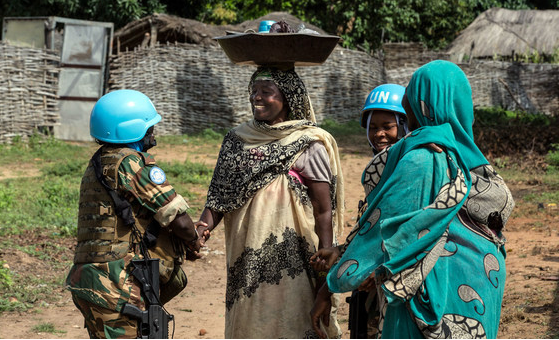
Source: UN News
Women’s peacekeeping forces are also helping to alleviate the disproportionate adverse impact of conflict on women, addressing the needs of women in conflict and post-conflict environments – including assisting ex-combatants and female soldiers in the process of demobilization and reintegration into civilian life. Such women’s peacekeepers serve as mentors and role models to set an example for affected women and girls in enforcing their own rights. Peacekeeping forces ensuring the meaningful and equal participation of women in peace operations and political processes are key to the effective building of lasting peace.
| The United Nations fully supports the strengthening of the role and participation of women in peace processes and the increase of women’s participation in peace, and we will raise this issue on other occasions. Increasing and promoting the full and equal participation of women in conflict prevention and resolution, peace negotiations, peace-building and peacekeeping is a key prerequisite for sustainable peace. Women are key players in supporting the three pillars of lasting peace: economic recovery, social cohesion and political legitimacy. In connection with UNSC Resolution no. 1325 “Women, Peace and Security” we support initiatives aimed at training civilians and military personnel of peacekeeping missions on gender issues, violence, as well as greater involvement of women in crisis management missions and the UN peace architecture in general . Emphasis needs to be placed on post-conflict reconstruction programs to meet the needs of women and girls. The role of women in all aspects of security, conflict resolution and peacekeeping operations needs to be strengthened. We start from the fact that, on the one hand, women are exceptionally severely affected by armed conflict, but on the other hand, they can play a key role in preventing and resolving them. We therefore call on all actors to increase women’s participation and to integrate equal opportunities into all national and international peace efforts. |


